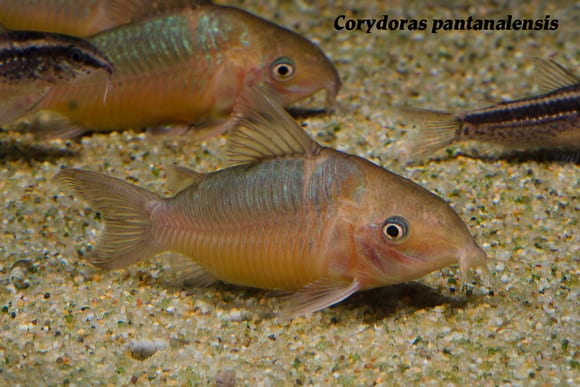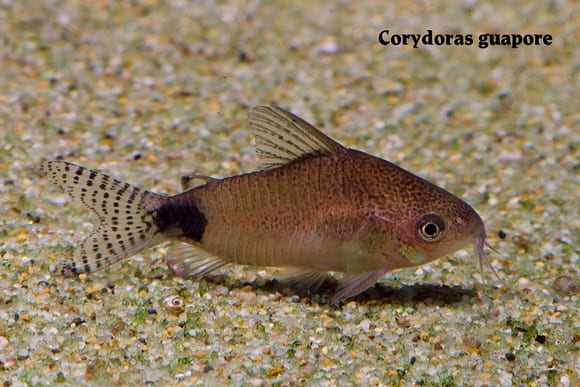You Only Live Ninece
You Only Live Ninece
Familiar to all, but especially to those with feline friends, is the old axiom that cats have 9 lives. Largely in part to their enlarged cerebellums, or the “motor center” of their brains, cats are known for “turning up” unscathed after performing daredevil acts at great heights. There are certainly benefits to having a hardy pet, but, what about a fish that always ends up on its…fins..?..? We may not be taking a great leap here in invoking catfish for this analogy, but there is a particularly apt group of armored catfish to fit this mold. Popular for their good-natured energy, small size, general adorableness, and of course, hardiness, are the acclaimed Corydoras.
A staple in community tanks, especially among beginner hobbyists, Corydorasare bottom-dwelling, small, armored catfish found in streams, ponds, marshes, and marginal regions of larger rivers in South America. They do best in tanks with a thick layer of about 2 inches of sand or smooth gravel substrate, though gravel must be kept scrupulously clean. Corydoras also enjoy a plethora of furnishings like driftwood and smooth rocks, and thrive in densely planted setups including some floating vegetation to filter the light. Tank waters are best maintained with temperatures between 72 and 79°F, pH of 5.5 to 7.5, and hardness around 36 to 215 ppm.
All “Cories” have bony plates covering their bodies, and soft barbel-whiskers around their mouths for sensing food. As foraging omnivores, their natural diets consist of small invertebrates and various vegetal materials. In captivity they should be fed varied, high-quality sinking foods with regular live and frozen offerings, which they will consume from the bottom substrate with their faces buried up to their eyes. Corydoras species are often restricted to small natural ranges, and along with this they display distinct characteristics including body shapes and coloration. A few of our current favorites include Corydoras gracilis, Corydoras pantanalensis, and Corydoras guapore.
Scientific NameCorydoras gracilis
Common NameN/A
Temperature / pH72 to 79°F / 5.5 to 7.5 pH
Native LocationBrazil
Preferred DietSinking foods
Species epithet translating to “slim”, C. gracilis is a narrow-bodied congener of this group. They reach up to 1.5 inches and exhibit a dark lateral stripe extending from snout to tail. Native to the central Amazon of Brazil, they prefer minor tributaries with dense riparian vegetation and acidic, tannin-stained waters. Thus, the addition of dried-leaf litter to their setup will keep this species particularly happy.
Scientific NameCorydoras pantanalensis
Common NameN/A
Temperature / pH72 to 79°F / 5.5 to 7.5 pH
Native LocationPantanals
Preferred DietSinking foods
Named for its native range in the Pantanals, the largest wetlands in the world, C. pantanal is a slightly larger species, reaching 3.5 inches in length. With shining bodies that match the crystal-blue waters of their natural habitat, these Cories are tan with mottled green shining scales. For a more natural environment, make sure to have bright lighting and lots of tall and floating vegetation present.
Scientific NameCorydoras guapore
Common NameN/A
Temperature / pH72 to 79°F / 5.5 to 7.5 pH
Native LocationBolivia
Preferred DietSinking foods
Known, at least in our circle, as one of the cuter Corydoras, C. guapore reaches 2 inches in length, has big, bright eyes, a slightly humped back, mottled black markings all over their flesh-toned bodies, and a dark blotch at the base of their caudal fin. Endemic to the Rio Guapore in Bolivia and western Brazil, this species thrives in warm, tannin-stained waters. For a more natural feel, include several driftwood pieces, roots, and tangles along their sandy substrate.
While Corydoras, or any known living thing for that matter, only have 1 true life, they are certainly a good long-lived and hardy staple of any community tank. With over 30 available Cories in our tanks, there’s a good-natured and jubilant whiskered friend for everyone.


